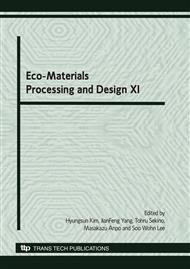p.448
p.452
p.456
p.460
p.463
p.467
p.471
p.475
p.479
Preparation and Dielectric Properties of Alumina Filled Epoxy Nano-Composite
Abstract:
The reported enhancement in dielectric properties obtained for polymer nano-composite seemed to be very encouraging. To further understand the dielectric behavior of epoxy nano-composite, aluminum oxide (Al2O3) nano-particles were incorporated into bisphenol A epoxy resin, and the dependence of nano-particle content and the dielectric properties was investigated in this study. Results showed that, when nano-particle contents was no more than 10phr, relative permittivity (εr) decreased to be lower than that of monolithic epoxy, and the minimum value appeared in 4phr nano-particle filled composite. The minimum value of tan delta (tanδ) appeared in 6phr nano-particle filled composite. DC volume resistivity (ρv) increased due to the introduction of nano-particles when the filler content is very small (about 2phr).
Info:
Periodical:
Pages:
463-466
Citation:
Online since:
July 2010
Authors:
Price:
Сopyright:
© 2010 Trans Tech Publications Ltd. All Rights Reserved
Share:
Citation:


